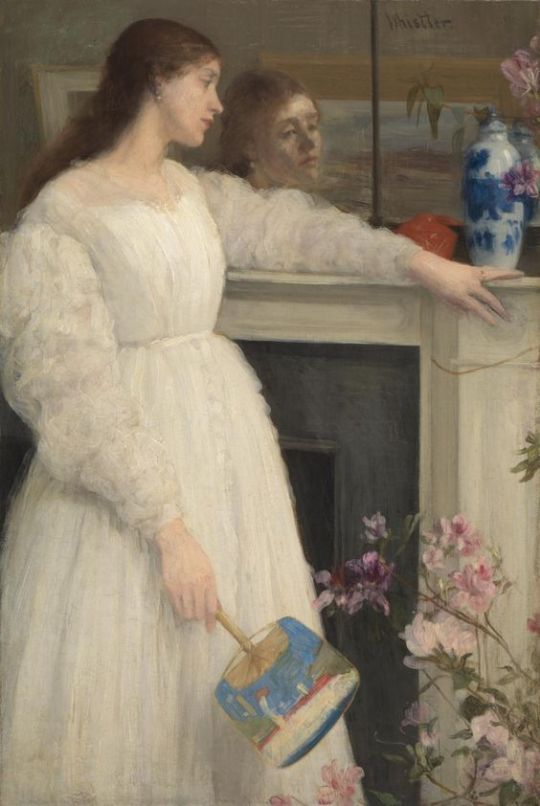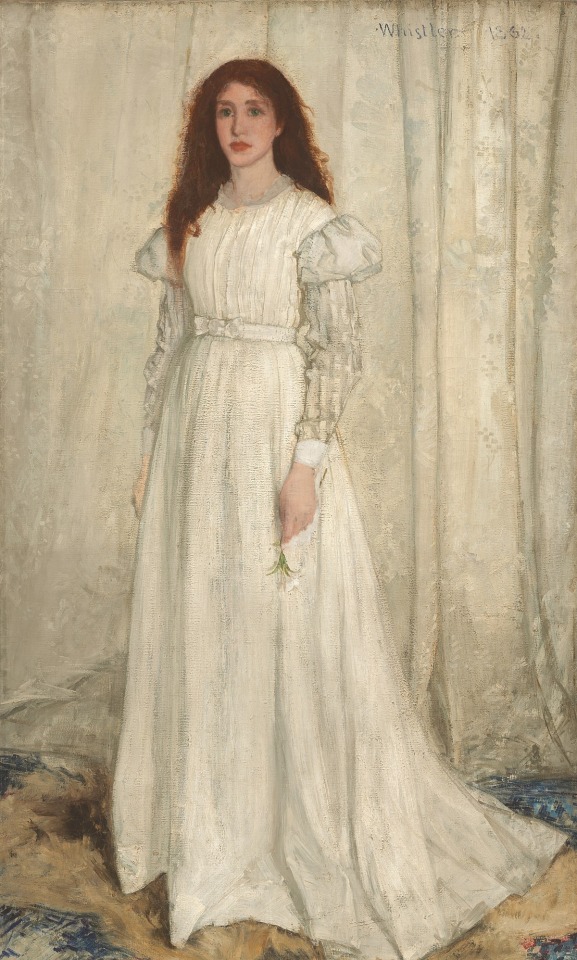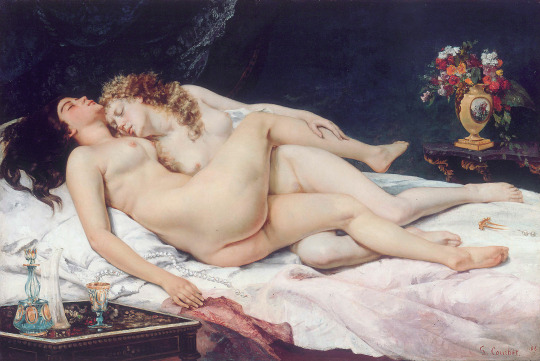#Joanna Hiffernan
Explore tagged Tumblr posts
Text

Gustave Courbet - Jo, La Belle Irlandaise (1866)
Uma série de quatro retratos a óleo sobre tela na altura do busto feitos por Gustave Courbet. A modelo irlandesa Joanna Hiffernan foi musa de Coubert e também de James McNeill Whistler, com a obra Symphony in White, No. 1: The White Girl.
Na wiki da Joanna diz que ela também pintava, mas não se tem registros das obras.
1 note
·
View note
Photo



James McNeill Whistler (1834 - 1903)
Symphony in White, No.1: The White Girl Portrait of Joanna Hiffernan (1862) detail
Symphony in White, No. 2: The Little White Girl (1864) detail
Symphony in White, No. 3 (1867) detail
#artedit#art history#art detail#19th century#xix century#painting detail#painting#painting details#art details#art#james mcneill whistler#mine
44 notes
·
View notes
Photo


”Symphony in White, No. 1: The White Girl” (1861-62)
“Symphony in White, No. 2: The Little White Girl” (1864)
by James McNeill Whistler
#james mcneill whistler#19th century#art#artblr#art history#fashion#joanna hiffernan#women in art#light academia#muse#historical fashion#muses#white dress#femininity#tate britain#tate museum#hulderposts
30 notes
·
View notes
Text






(how I spent my lunch break)
#royal academy#royal academy of arts#james mcneill whistler#Joanna Hiffernan#oil on canvas#symphony in white#muse#aesthetic movement#tonalism#gentle spring#frederick sandys#proserpina#pre raphaelite#fine art#Venus#aphrodite#dancing faun#marble sculpture#light acadamia aesthetic#the annunciation#dante gabriel rossetti#lillies#auburn
34 notes
·
View notes
Text
Who was the model for Whistler's 'Symphony in White, No 1: The White Girl' (1861-63)?

Joanna Hiffernan’s reputation as the “Woman in White” developed after posing for Whistler’s painting 'The White Girl' (1861-63), later renamed 'Symphony in White, No 1'. Two more 'Symphonies in White' followed, which inspired other artists to paint similar scenes.
Hiffernan was born in Limerick, Ireland, in 1843, but moved with her family to London at the age of two to avoid the Irish Potato Famine. James Abbott McNeill Whistler (1834-1903) was born in Massachusetts, USA, to Anna McNeill (1804-81) and George Washington Whistler (1800-49). His mother is the subject of one of Whistler’s most famous paintings, 'Arrangement in Grey and Black No.1', more commonly known as 'Whistler’s Mother' (1871).
In 1860, Whistler met Hiffernan for the first time in London and fell in love with her copper coloured hair. Whistler started including Hiffernan in his paintings, and she eventually became his lover. Whistler’s iconic 'Symphonies in White' marked a turning point in his career and introduced Hiffernan to the world. Whistler began the first of the three paintings in Paris in 1861 and submitted it to the Royal Academy in May 1862 under the title 'The White Girl'.
After splitting from Whistler in 1866, she looked after Whistler’s son, the result of an affair with a parlour maid. Hiffernan’s probably died in 1886 after a short illness. Other sources claim Hiffernan died in 1903 after attending Whistler’s funeral but this was probably Hiffernan’s sister, Agnes.
5 notes
·
View notes
Photo

Jo, the Beautiful Irishwoman, 1866, by Gustave Courbet (1819-1877)
This painting in unique as it directly references its sitter by her first name: Joanna Hiffernan (c.1843 - c.1905). Many paintings did not usually refer to their muse on such friendly terms, but it succeeds in giving this one an even warmer air to it.
#art#art history#Jo the Beautiful Irishwoman#art history blog#french art#Gustave Courbet#french#france#19th century#portrait#Joanna Hiffernan#artwork#painting#1800s#1860s#1860's#1800's
857 notes
·
View notes
Link
0 notes
Photo

A White Note (1862). James McNeill Whistler (American, 1834-1903). Oil on canvas. Colby College Museum of Art.
A White Note features Joanna “Jo” Hiffernan, Whistler’s primary model and studio manager in the 1860s who posed for the artist’s series of Symphony in White paintings. This work shows the influence of the English painter-poet Dante Gabriel Rossetti. Whistler’s representation of a lone woman, devoid of any social context or moral message, expresses the sensibility of the emerging Aesthetic Movement then led by Rossetti. Whistler would become the chief spokesman for the movement, advocating an “art for art’s sake” focused on line, form, and color in the pursuit of beauty. Whistler and Rossetti became close friends in 1863, and A White Note was in Rossetti’s possession upon his death in 1882.
34 notes
·
View notes
Text
Anti-Valentine’s Day
There are a lot of reasons to be upset recently. The changing political climate, immigrants being denied entry to our country, learning that Lady Gaga didn’t actually jump off the roof at the Super Bowl half time, and now to top it all off that one day a year designed to remind people how lonely they really are is upon us. Yes, the day of love letters, roses, and cheap heart shaped box chocolates is right around the corner. You may be thinking, I snagged me a Valentine this year so maybe things aren’t so bad. Well, I am here to remind you that even the most doting of relationships can turn sour.
Some say that artists feel emotions stronger than the average bloke, hence why they feel so compelled to tell their story by any means necessary. If that is the case, we can only assume they love hard, and hate even harder. We at Sartle love a juicy breakup story and if time had taught us anything it is this: the worse the relationship, the better the art. So here’s to some great art and terrible relationships!
Frida Kahlo and Diego Rivera
When thinking about bad artist relationships, the Frida and Diego fiasco always seems to find its way into the convo; probably because their relationship was all kinds of messed up. To give you a taste for what their relationship was like, listen to this gem of a quote from Kahlo, “I suffered two grave accidents in my life. One in which a streetcar knocked me down…The other accident is Diego.” If you openly admit that your husband is one of the great mistakes of your life, you might want to reevaluate your life decisions.
Where do I even start with these two? They met in 1928 and a year later were hitched. Besides the fact that Diego was almost twice her age, this was his third marriage, which probably should have been a red flag for young Frida, but when the heart wants what it wants, common sense goes out the window. It only took two years for the affairs to begin and honestly, they never really stopped. They both had endless lovers, sometimes out of desire, and sometimes they just did it to piss the other one off. Why Diego decided to cheat on Frida with her little sister though will continue to remain a mystery.
Not surprisingly the two divorced, but ultimately ended up marrying again just one year later. Needless to say, nothing really changed and they returned to their tumultuous ways until Kahlo’s death fourteen years later.
Frida and Diego Rivera by Frida Kahlo, San Francisco Museum of Modern Art
Camille Claudel and Auguste Rodin
Sometimes it can feel as though our relationships are driving us crazy. In the case of Camille Claudel though, that is literally what happened after spending a bit too much time obsessing over the famed sculptor Auguste Rodin. Shortly after beginning her sculpting career, Rodin needed an assistant to help expedite his artistic practice, and Claudel was just the woman to do it. It didn’t take long for the two to start lusting after each other and with time, stone was no longer the only thing getting pounded down in that studio. The two shared an intense relationship that fueled their creative outlets as well. It was pretty much perfect, except for one little thing: Rodin was already married.
Claudel pleaded and begged, but Rodin refused to leave his wife…and this is when things started to get ugly. Claudel grew furious, she ain’t nobody’s mistress! As this vengeful side of Claudel began to become apparent to Rodin, he decided that she had become too much baggage for a fun fling and decided to boot her from his life. Claudel soon grew neurotic and experienced a complete breakdown, which landed her in a mental hospital where she lived until her death. That’s amore?
The Mature Age by Camille Claudel, Orsay Museum
Pablo Picasso and Marie-Thérèse Walter
Since it appears that we have now entered the territory of lovers on the down low, we cannot forget about art history’s biggest playboy/womanizer: Pablo Picasso. Picasso had two marriages, six mistresses, and hundreds of other conquests (and who knows how many venereal diseases). Let’s have a gander at Marie-Thérèse Walter, for her tale is a brutally sad one, and as you know, we’re sticking with the theme that romance is probably dead. This dreamy saga started when Marie-Thérèse was only 17 years old, just a tad younger than Picasso’s 45. At the time their little affaire de coeur started, Picasso was already hitched to Olga Khokhlova, but as we know, the whole sanctity of marriage thing was a bit drab for the salacious artists.
The affair went on for eight years before Olga uncovered his philandering ways and ultimately took their children and skipped town. “Yes!” Marie-Thérèse must have thought “now I have him all to myself”. Wrong, so wrong. She should have known that old habits die hard. His eyes soon wandered to his next lover and muse Dora Maar. Rumor has it that when Marie-Thérèse found out about Dora, the two ladies entered into a physical catfight over the man’s affection. Marie-Thérèse ultimately lost and Picasso threw her out like day old chowder. Nonetheless, Marie-Thérèse never stopped loving him, and after his death, she hung herself out of sorrow.
Nude Woman in a Red Armchair by Pablo Picasso , Tate Britain
Gustave Courbet, James Whistler, and Joanna Hiffernan
The tale of Gustave Courbet, James Whistler, and Joanna Hiffernan serves as a solid reminder that bros before hoes is actually some pretty good advice. Back in the day, painter James Whistler fell for the vivacious ginger Joanna Hiffernan. Sadly, when introduced to his family, they felt she was too loose and could not approve of his dating her. Turns out they may have been right about the whole hussy thing, but we’ll get to that later. Hiffernan decided to ignore his parents advice and develop what became a six year long relationship in which she both loved and modeled for him.
Whistler had a whole slew of cool artsy friends, one of which included painter Gustave Courbet. Naturally, Whistler introduced him to Jo and it didn’t take long for things to start blowing up. After learning that Courbet probably had an affair with Jo, and that he definitely painted a picture of her vagina, their friendship soon fell into peril. Shocker. Turns out painting an awkwardly up-close painting of your friend’s girlfriend’s hooha is totally against bro code protocol. Their friendship soon ended and ultimately neither of them ended up with Joanna. Turns out Whistler’s parents may have known what they were talking about after all.
Portrait of Jo, the Beautiful Irish Girl by Gustave Courbet, Metropolitan Museum of Art
Love is messy business. Perhaps that is why we invented Valentine’s Day to convince us that the tumultuous desires of the heart are actually a good thing. Or maybe it is just to sell us stuff we don’t need; Hallmark, I got my eye on you. Either way, to all you Valentine’s Day haters out there, I hope this blog has taught you one thing: maybe single life ain’t so bad after all.
By: Jennifer
#very silly#valentine's day#anti-valentines day#art history#love#frida kahlo#diego rivera#auguste rodin#pablo picasso#gustave courbet#james abbott mcneill whistler#camille claudel#marie-therese walter#olga khokhlova#joanna hiffernan#frida and diego rivera#san francisco museum of modern art#the mature age#orsay museum#nude woman in a red armchair#tate britain#portrait of jo the beautiful irish girl#metropolitan museum of art
6 notes
·
View notes
Photo

Gustave Courbet - Le Sommeil (The Sleepers), 1866, - 1866: acquired by Halil Şerif Pasha - 1868: acquired by Jean-Baptiste Faure - 1953: acquired by municipality of Paris
Joanna Hiffernan and Constance Quéniaux are depicted here.
#art#arte#classic#classical#classic literature#classical art#classical painting#painting#painter#French Painter#french paint#french art#french artist#gustave courbet#le sommeil#the sleepers#1866#1800#1800s#1800 painting#paris#joanna hiffernan#constance queniaux
928 notes
·
View notes
Photo

Have you heard the story of a woman portrayed in this masterpiece? Joanna Hiffernan and James Abbott McNeill Whistler met in London in 1861. He instantly fell in love with her striking red hair and outspoken character and the couple soon moved to Paris where Hiffernan became Whistler’s muse, partner, and modèle privilégié. For six years, Whistler couldn’t stop painting his muse. Her image became his obsession. Hiffernan managed Whistler’s accounts, organized their domestic life, and acted as an endless source of inspiration, while also being an artist in her own right. #Repost @dailyartmagazine Read ➡️ "Joanna Hiffernan: Artist, Model and Whistler’s Muse" [🔗link in bio] 🖊 Louisa Mahoney @weeezybabyy 🖼 James McNeill Whistler, Symphony in White, No. 2: The Little White Girl, 1864, @tate #jamesmcneillwhistler #jameswhistler #joannahiffernan #impressionism #artherstory #19thcenturypainting #artoftheday https://www.instagram.com/p/CjzQSYxomdT/?igshid=NGJjMDIxMWI=
#repost#jamesmcneillwhistler#jameswhistler#joannahiffernan#impressionism#artherstory#19thcenturypainting#artoftheday
4 notes
·
View notes
Photo

MWW Artwork of the Day (3/21/22) Cecilia Beaux (American, 1855–1942) Sita and Sarita (1896/c. 1921) Oil on canvas, 113.3 x 83.8 cm. National Gallery, Washington DC (Corcoran Collection)
This portrait by Cecilia Beaux portrays the artist's cousin, Sarah Allibone Leavitt, dressed in white with her black cat on her shoulder. The sitter's white dress, for instance, evokes Whistler's infamous 1862 painting of Joanna Hiffernan, "Symphony in White, No. 1: The White Girl" (National Gallery of Art, Washington). The formal connection between the two paintings demonstrates Beaux's knowledge of Whistler's painting. Additionally, the direct gaze of the black cat perched on Sarah's shoulder references Edouard Manet's painting "Olympia" (1865, Musée d'Orsay, Paris), in which a similarly posed black cat sits at the foot of Olympia's bed. These connections suggest that Beaux intended to reveal more with this portrait than simply her mastery of painting technique. The enigmatic title of the painting may represent Manet's influence —- Beaux's use of Spanish diminutives, Sarita for Sarah and Sita, meaning "little one," for the cat, acknowledges the late 19th-century popularity of Spanish painting, championed by Manet.
15 notes
·
View notes
Note
Do you know why Whistler almost painted white Joanna Hiffernan. Does it have any special meaning? Thank you.
Hello! I've gathered some sources detailing Whistler's and Hiffernan's relationship, as well as sources about the painting in question. I'm not sure if it says anywhere why he painted her in all white but hopefully you'll be able to get some insight from the sources below. National Gallery of Art, "The Woman in White: Joanna Hiffernan and James McNeill Whistler" https://www.nga.gov/exhibitions/2022/woman-in-white.html National Gallery of Art, "The Woman in White" https://www.nga.gov/features/woman-in-white-joanna-hiffernan-and-whistler/joanna-hiffernan-the-white-girl.html Royal Academy, "Whistler's Woman in White: Joanna Hiffernan" https://www.royalacademy.org.uk/exhibition/whistler-woman-in-white Hiffernan's Wiki page for general background on her life https://en.wikipedia.org/wiki/Joanna_Hiffernan Art&Object, "The Woman in White: Joanna Hiffernan's Influence on James Whistler" https://www.artandobject.com/articles/woman-white-joanna-hiffernans-influence-james-whistler The Woman in White: Joanna Hiffernan and James McNeill Whistler by Margaret F. MacDonald, a book about Hiffernan and Whistler's relationship. You can probably get this through a library I hope you find what you're looking for! If you have anymore questions or would like more help feel free to ask, I'm happy to help 😊
11 notes
·
View notes
Photo

James Abbott McNeil Whistler - Sinfonia in bianco n. 2: ragazzina in bianco - 1864
Secondo di una serie di tre dipinti che raffigurano ragazze vestite di bianco, della fase “orientale” di Whistler. La modella è la sua amante dai capelli rossi Joanna Hiffernan. Vestita di bianco, con il braccio poggiato sulla mensola del caminetto, guarda il suo volto riflesso nello specchio. Una atmosfera poetica d malinconia sognante pervade l‘immagine. L’interesse di Whistler per gli oggetti giapponesi è sottolineato dal ventaglio dipinto e dal vaso bianco e blu, ma l’influenza dell’arte giapponese è evidente in tutta la composizione. La superficie della tela è divisa da linee semplici e ampie campiture di colore, con fiori rosa che emergono dall’angolo in basso a destra per enfatizzare la superficie dell’immagine e per contribuire al suo fascino decorativo.
Questo capolavoro di Whistler ispirò l’amico Algernon Swinburne a scrivere la poesia Davanti allo specchio, poi incollata alla cornice in occasione dell’esposizione del dipinto alla Royal Academy.
2 notes
·
View notes
Text
From February to May 2022, the Royal Academy of Arts explored the work of James McNeill Whistler, particularly those featuring a certain red-haired woman. Whistler’s paintings of Joanna Hiffernan helped him forge his reputation as one of the best-known names of the late 19th-century Aesthetic Movement. Rather than solely focusing on the artist, the RA uncovered the role Hiffernan played in Whistler’s life and her influence on future artists, particularly the Pre-Raphaelites.
Whistler’s Woman in White: Joanna Hiffernan is open until 22nd May 2022. Tickets cost £15 for adults, except for Friends of RA, who may visit for free.
My blogs are now available to listen to as podcasts on the following platforms: Anchor, Breaker, Google Podcasts, Pocket Casts and Spotify.
If you would like to support my blog, become a Patreon from £5p/m or “buy me a coffee” for £3. Thank You!
#Me#Whistler#Joanna Hiffernan#Art#The White woman#Woman in White#Paintings#Royal Academy#Exhibition#Whistler's woman in white
6 notes
·
View notes
Photo

Symphony in White No.1: The White Girl (Portrait of Joanna Hiffernan), 1862, by James Abbott McNeill Whistler (1834-1903)
#Symphony in White no 1: The White Girl (Portrait of Joanna Hiffernan)#1800's#19th century#art#art history#James Abbott McNeill Whistler#art history blog#Symphony in White No.1: The White Girl (Portrait of Joanna Hiffernan)#Symphony in White No.1#Symphony in White#The White Girl#Portrait of Joanna Hiffernan#portrait#painting#artwork
390 notes
·
View notes